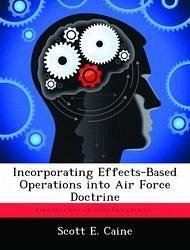In the aftermath of the 1991 Gulf War, numerous military and airpower analysts hypothesized that the nature of warfare had fundamentally changed. In the forefront of the concepts that emerged from this period, "effects-based operations" (EBO) has been written about and debated at length. While it appears that the USAF has embraced the concept, the service has done little to codify in practice and make EBO part of the airman's lexicon. This paper explores the practical codification of EBO in Air Force doctrine. The study first analyzes the effects-based concept and the inherent pitfalls associated with it. Instead of focusing on targets and destruction; effects-based operations focus on desired effects and their impact on achieving objectives. The plan-execute-assess process has increased importance because effects cannot normally be measured as easily as physical destruction. The concept of effects-based operations has simple roots with complicated implications. The study analyzes previous campaigns in a framework of effects-based aspects.








